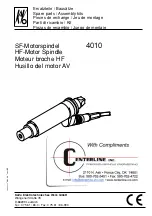
1
1-1
Section
Tester
Basics
— Description of Controls and Accessories
— Installing and Checking the 9 Volt Battery
Note: Detailed procedures for testing sensors and ignition modules are
located in Section 2 (sensors) and Section 3 (ignition modules).
Controls power to the Tester and selects measure-
ment range sensitivity (as required by various
sensor tests).
• POWER OFF - No power supplied to either the
tester or RED test lead.
• LOW - Tester powered up for use. Voltage from
9 volt battery supplied to RED test lead. Selects
range for measuring low levels of voltage,
resistance or frequency.
• HIGH - Tester powered up for use. Voltage from
9 volt battery supplied to RED test lead. Selects
range for measuring higher levels of voltage,
resistance or frequency.
Selects the type of signal being measured (for
conducting sensor and ignition module tests). Different
kinds of signals are used by various sensors.
• VOLTS - Measures voltages. This function is used
to test most sensors.
• OHMS - Measures resistance. Also used for
checking continuity and testing diodes (see section
4). Mostly used for testing temperature sensors.
• FREQUENCY - Measures frequency signals.
(Peak signal voltage must be at least 3 volts
to register.) Some MAP and MAF sensors
send a frequency signal. This function is
also used to test ignition modules.
1
RANGE
Switch
FUNCTION
Switch
2
Summary of Contents for CP9087
Page 82: ...3 22 Notes...






































